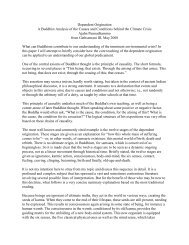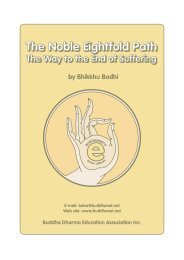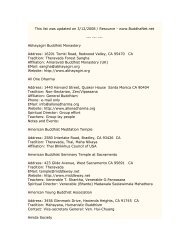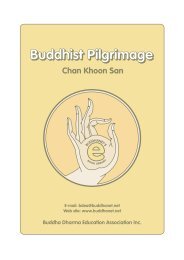FEARLEss MOUNTAIN - Urban Dharma
FEARLEss MOUNTAIN - Urban Dharma
FEARLEss MOUNTAIN - Urban Dharma
Create successful ePaper yourself
Turn your PDF publications into a flip-book with our unique Google optimized e-Paper software.
(continued from page )<br />
in a way which is going to be agitating, it’s going to lead to an<br />
agitated future. But if I respond with this sense of peace . . .” So<br />
whatever it was, whatever the whole history of causes and conditions<br />
had produced in this moment, pleasant or unpleasant, I<br />
could create my future moment-by-moment through responding<br />
with peace. Meditation is of course a<br />
central feature in our lifestyle. Before I<br />
went to Wat Pah Nanachat I was doing<br />
a long meditation retreat in Thailand,<br />
and it was more of the vipassanā style.<br />
I was told “Well, you’re welcome to do<br />
samatha meditation if you want, but it’s<br />
basically a waste of time—it makes you a little peaceful, you get<br />
a little happiness, but you get attached to it and then you end up<br />
just as stupid as you ever were. But vipassanā—that’s the essence<br />
of wisdom, that’s the thing which is going to liberate you.” So I<br />
said “great!” and put all of my energy into it. By the time I got<br />
to Wat Pah Nanachat, I realized, “Actually what I need is some<br />
peace.” And Luang Por Chah, he didn’t make this big distinction<br />
between samatha and vipassanā. He said, “Well, we know<br />
what flowing water is. You can go down to the creek and study<br />
how water flows by and around the rocks and it’s a real study<br />
and learning about our minds as well, just watching how water<br />
flows. If we’ve had the experience of seeing a really still pool<br />
somewhere,” Ajahn Chah would say, “Well, we know what it’s<br />
like when it’s still, absolutely still.” I had been a ranger up in the<br />
Sierra Mountains up above the tree line and had seen these pools<br />
and lakes that were just snow melt, freshly melted from snow<br />
and glaciers—absolutely still and clear. No wind, and you could<br />
look right through the water and no matter how deep it was it<br />
seemed you could see all the detail of the rocks and everything<br />
on the bottom. That was such a beautiful simile for the still<br />
mind. “But,” Ajahn Chah says, “even if we know what water is<br />
like when it’s still, what we don’t know is still flowing water.”<br />
This is one of my favorite similes of Ajahn Chah’s—still flowing<br />
water—this paradox: when water flows, then we can understand<br />
that and when it doesn’t flow then it’s still. And when it’s still it<br />
doesn’t flow, it’s not moving. But how can it be flowing and still<br />
at the same time This is what we need to figure, this is what<br />
we need to know firsthand. And as we know, the Buddha didn’t<br />
just teach the Dhamma. He taught Dhamma-Vinaya. When he<br />
talked about meditation he didn’t just teach vipassanā, he taught<br />
samatha-vipassanā.<br />
I think it was Ajahn Buddhadasa who first came up with<br />
this simile of samatha and vipassanā being very much like a knife.<br />
His simile was of the practitioner as someone who’s carving away<br />
through a dense jungle, a dense thicket. One doesn’t need to cut<br />
down the whole jungle; one just needs to cut a path through the<br />
jungle to get to the other side. The tool to work with is the meditation.<br />
To be able to use the tool effectively, to have an effective<br />
I see samatha to be a rock and<br />
not to roll. And vipassanā is<br />
pure rock and roll.<br />
tool, it’s got to be both heavy and sharp. To try to get through<br />
the jungle with just a razor blade, clearly is not going to work. To<br />
try to get through the jungle with just a dull stick is not going<br />
to work. But when you combine the sharpness and the heaviness<br />
then you get one of these Thai machettes and with systematic<br />
effort and persistence, you can make your way through the jungle<br />
bit-by-bit, vine-by-vine, tree-by-tree.<br />
This was Ajahn Buddhadasa’s simile<br />
for samatha and vipassanā. Vipassanā<br />
was that sharpness, that clarity of<br />
mind, that investigative edge, where<br />
samatha was the weight behind it, the<br />
oomph, the power. It gives it something.<br />
Even if there’s a lot of energy, if you just have this tiny<br />
razor blade edge, it doesn’t work very well. Actually one of the<br />
similes I like with samatha and vipassanā is that I see samatha to<br />
be a rock and not to roll. And vipassanā is pure rock and roll.<br />
If we look at how the Buddha talked about the causes and<br />
conditions that lead to enlightenment and liberation, if we look at<br />
yathā-bhūta-ñāna-dassanam, seeing things as they clearly are in<br />
accordance with reality, what’s the cause and condition for that<br />
Well, it’s samādhi. It’s a very important thing. Also it’s important<br />
to recognize that the cause and condition that the Buddha said<br />
led to samādhi was sukhā, happiness, and how important that<br />
sense of happiness is in one’s life, in one’s meditation. It’s something<br />
we can systematically develop. We tend to think, “Well, at<br />
the end of the path there’s going to be happiness, maybe I’ll have<br />
suffering in between but finally, someday I’m going to be happy.”<br />
But the Buddha was saying even before we get to advanced stages<br />
of insight, even before we can learn how to really make the mind<br />
peaceful, we have to learn how to be happy enough, developing<br />
happiness in the lifestyle, in the meditation, actually focusing<br />
on it. One of the paradoxes of spiritual life I find is that we have<br />
everything we need to be happy right here and now and yet, at<br />
the same time, there’s clearly something to be done. So if we have<br />
everything we need to be happy right here and now, why not just<br />
be lazy and complacent But if we realize that we have enough<br />
right here and now to give rise to a certain level of contentment,<br />
then whatever it is—pleasant, painful, a lot or a little, it’s enough<br />
to be content with it. This type of contentment is that happiness<br />
which can lead to peace of mind. Going back into “peace, peace,<br />
peace,” Then it’s just natural. The more calm the mind is, the<br />
more clarity there is. And the more clarity there is, the more we<br />
let go of all the things which agitate and disturb the mind. And<br />
then the more peaceful the mind becomes, the more clarity there<br />
is. So the way the ajahns in the Forest tradition talked about the<br />
whole samatha-vipassanā issue was not to make a big distinction<br />
between the two from the very beginning. We’ve got to use<br />
wisdom every moment throughout the day to try to understand<br />
why it is that we’re not peaceful. What are the obstacles to peace<br />
Whatever our lifestyle is, monastic or lay, we’ve got to deal with<br />
Spring 2007 • 11


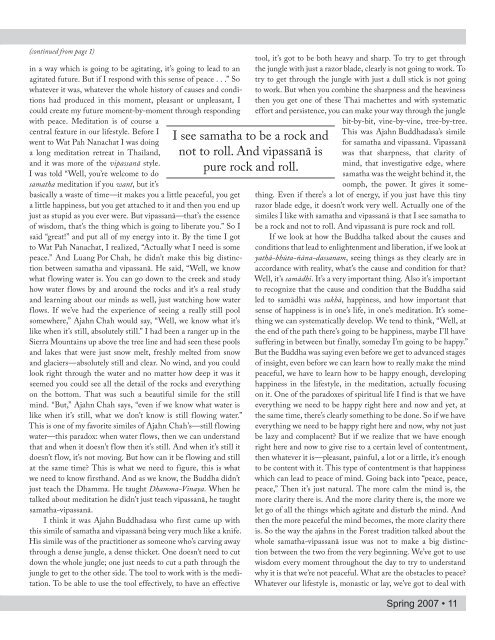
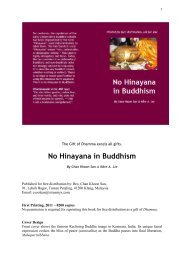

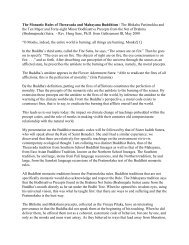



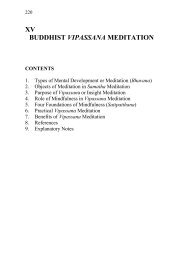

![Path of Freedom [Vimuttimagga] - Urban Dharma](https://img.yumpu.com/34050512/1/177x260/path-of-freedom-vimuttimagga-urban-dharma.jpg?quality=85)
